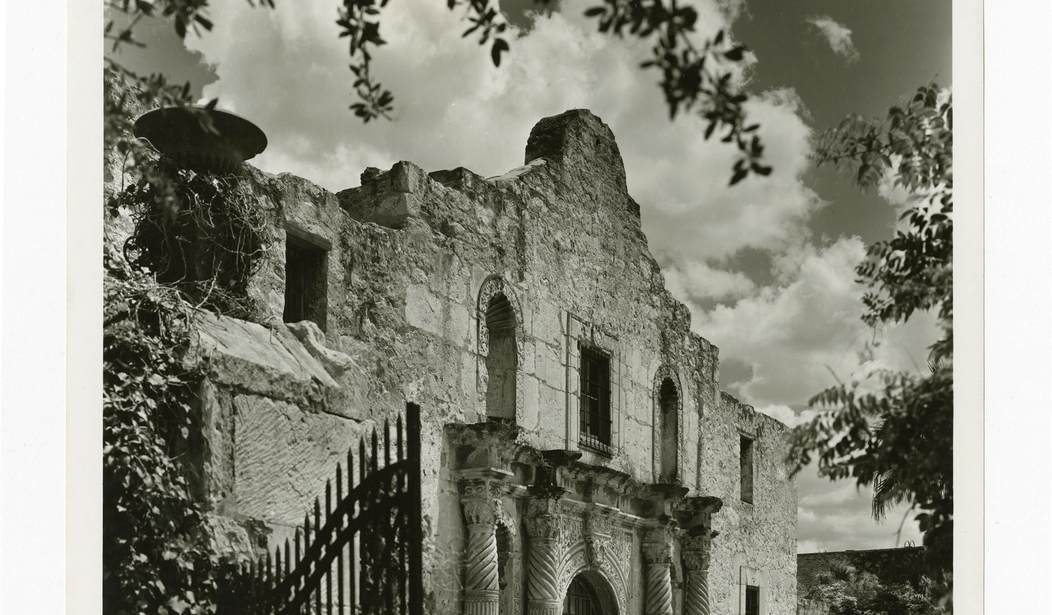To keyboards! Another media attack has been launched at the Alamo!
Hardly a fortnight goes by now between media-left cartoon treatments of the 1836 battle that serves as the crescendo of the Texas Revolution, the brief war that made modern Texas and changed North America. Politico’s latest is no exception, though at least this piece omits the customary John Wayne movie references.
Retired journalist Rick Casey’s recent attempt at Texas history, however, serves up the 1960 film for mockery, and by extension, for mocking interest in the battle and its most famous figures.
The book, like many scholars, witheringly ridicules John Wayne’s movie, which establishes the virtue and heroism of the Holy Trinity of Travis, Bowie, and Crockett.
This is not true and it’s easily checked. Their heroic reputations were established by their deeds at the Alamo and lauded by newspaper reports and other accounts from the 19th century that still exist. Not on a field in an Alamo movie set west of San Antonio.
By the time John Wayne made his epic, the Alamo had already been depicted numerous times in books and films. He just brought more star power and a bigger budget to the story.
Yes, movies get things wrong all the time. Have you ever seen Oliver Stone’s JFK? Or anything Michael Moore has ever made? Journalists get things wrong all the time too.
There is a “So what?” factor to this allegation. I worked at NASA with numerous astronomers whose interest in space began with Star Trek or Star Wars. They went on from there into true science. The same is often true for those interested in history or archaeology. This doesn’t discredit them. The movie was a gateway to much deeper study and shouldn’t be used as a gotcha against them. For what it’s worth, I’ve only ever seen the John Wayne Alamo film once or twice and it had no influence on my interest in the subject. Phil Collins’ interest began with Disney’s Alamo treatments in the 1950s. So what? His interest and study didn’t end there, it started there.
The new critiques of the Alamo fall along predictable lines: the heroes weren’t heroic in their time but were revised to become heroes to serve a racist agenda later, the battle was foolhardy and unheroic, and the revolution itself was a racist landgrab and along with the Alamo represents white supremacy. All of these lines of attack are false.
It is true, as anyone who has studied the Alamo at all already knows, that the men who died there as heroes did not always lead heroic lives. This is well known and has been for ages. Didn’t even John Wayne’s film depict Bowie’s drinking before the battle, and his conflict with Travis over command? The 2004 Alamo film surely did. This is not news, is my point. It’s a key part of the defenders’ character development in the crisis they faced. Casey seems to think that’s a gotcha but anyone who has studied the Alamo at any depth knows Bowie, Crockett, Travis, and many others had numerous skeletons in their closets. That makes their actions at the Alamo all the more remarkable. Their actions at the Alamo demonstrate character development and are redemptive in nature.
They were regarded as heroes in their time, though, not merely later to serve a political agenda. Two of the defenders — David Crockett and Jim Bowie — were two of the most famous and admired men in America before ever setting foot in the Alamo. That doesn’t make them perfect; they were famous. There’s a difference. Humans have long made imperfect people famous. Gunslingers and outlaws were famous throughout the 19th century. Some of the Alamo defenders were famous as fighters before the battle, and heroes who died for liberty against a tyrant afterward. Their deaths in battle were shocking and sparked headlines all over the United States right after the battle. Jim Bowie’s brother, Rezin, became famous by association with his younger brother and gave out Bowie knives to friends and prominent figures of the day after the battle. One of those knives is in the Alamo collection today. Bowie knives were already popular before the battle and their popularity exploded afterward. No less than Capt. Juan Seguin lauded the Alamo heroes contemporaneously with their actions. He’s the Tejano leader who rode out of the Alamo through enemy lines during the siege with Travis’s famous “Victory or Death” letter. And he wasn’t Anglo.
On April 4, 1837, he hailed his friends, the Alamo defenders, thusly:
Companions in Arms!! These remains which we have the honor of carrying on our shoulders are those of the valiant heroes who died in the Alamo. Yes, my friends, they preferred to die a thousand times rather than submit themselves to the tyrant’s yoke. What a brilliant example! Deserving of being noted in the pages of history. The spirit of liberty appears to be looking out from its elevated throne with its pleasing mien and point to us saying: “There are your brothers, Travis, Bowie, Crockett, and others whose valor places them in the rank of my heroes.” Yes soldiers and fellow citizens, these are the worthy beings who, by the twists of fate, during the present campaign delivered their bodies to the ferocity of their enemies; who, barbarously treated as beasts, were bound by their feet and dragged to this spot, where they were reduced to ashes. The venerable remains of our worth companions as witnesses, I invite you to declare to the entire world, “Texas shall be free and independent or we shall perish in glorious combat.”
Sequin was there. He knew the defenders. He was one until he rode out seeking reinforcements. He makes his opinion of them quite clear, no John Wayne movie required.
Seguin also fought at San Jacinto. True, he was mistreated later by both Texas and Mexico. History, like real life, can get ugly and messy. But shortly after the war was over, he was put in command of San Antonio. Would a “white supremacist” republic do that? He did his best to gather up the burned remains of all of the defenders from the pyres on which Santa Anna had them burned and gave them a funeral. Why would he do that if they weren’t already regarded as heroes?
Texans regard Sequin as a hero now and he has a city named after him. He has a heroic statue too. A descendant of his leads a procession through San Antonio’s streets every year honoring the Texians and Tejanos who fought and died inside the Alamo in commemoration of Juan Seguin’s procession. None of this speaks to “white supremacy.”
As for the Alamo battle’s strategic value, it’s debatable quite apart from politics. It didn’t delay Santa Anna much. It did cost him a large number of troops. His treatment of the defeated certainly galvanized the revolutionaries to fight to the death. He left them no choice, especially after Goliad, when he ordered the 400 men who surrendered there executed. Santa Anna’s own officers bristled at his brutality but ultimately carried his orders out.
If there’s a common denominator between the two pieces discussed here, it’s journalists trying to do history despite having no background in the field. The last generations of mainstream media reporters all wanted to be Woodward and Bernstein uncovering a new -Gate scandal. Today’s apparently want to write up their own version of the (discredited on the facts) 1619 Project and topple all American history. Those who sometimes fail to get the first draft of history right ought to approach actual history with some humility. No dice, unfortunately.
What is their endgame? Is it merely to get clicks and sell books, or does it serve a larger political agenda? Given all the questioning of motives of the revolutionaries these journalists engage in, it’s fair to question their motives too. What are they up to?
And so we find Politico pushing the by now widespread hot take on the Texas Revolution — it was a racist land grab! — and the Alamo — it’s all a lie! Oh, and — it was all for slavery!
Nope, nope, and nope.
Critiques such as this fail to note a key fact: The revolution that included Texas wasn’t even confined to Texas. Texas, then part of Coahuila y Tejas, was but one of several states that rebelled, including San Luis Potosí, Querétaro, Durango, Guanajuato, Michoacán, Yucatán, Jalisco, Nuevo León, Tamaulipas, and Zacatecas. Texas was one of three territories that set up their own federalist republics during this period (along with the Republic of Yucatan and Republic of the Rio Grande).
Why? Santa Anna tossed out the federalist 1824 constitution and amassed power unto himself after claiming to be a federalist, among other things. He redrew federalist state lines into military districts, erasing their historic territorial boundaries. He engineered the laws so that only the rich could vote or hold political office. He did away with local legislatures. These were not small actions; they redrew the Mexican way of life. He did all of this during an age of revolution against kings and tyrants. He was a peacock and a thug who lost Texas with his brutal actions and kept getting himself kicked out of power for decades afterward. Boiling it all down to slavery and race is on-trend in our century but off the facts of the one in which the fighting took place. It ignores the fact that much of northern Mexico, far from Texas, revolted against Santa Anna. It ignores the fact that many high-ranking Mexican officials, such as Lorenzo de Zavala, rebelled. Texas was frontier and happens to be the one state that successfully broke away.
If the war in Texas was merely a local land grab, how does that explain the actions of one Gov. Francisco Garcia Salinas? Who was he? He was the governor of a Mexican state that was not Texas or colonized by Anglos that revolted against Santa Anna. Salinas personally led troops in the field against Santa Anna. Why?
Politico makes basic errors along with the narrative ones: present-day San Antonio was known as San Antonio de Bexar in the period of the Alamo battle, not “Bexar de San Antonio” as the piece alleges here:
Few subjects of Texas history have proved as contentious as what happened in early 1836 in a town then known as Béxar de San Antonio. But it started with a revolt.
Historical maps and documents agree on this. It was San Antonio de Bexar, not “Bexar de San Antonio.” Bexar is the larger jurisdiction, the county, surrounding the smaller San Antonio, the city.
When you get the simple things wrong, it’s tough to take you seriously on the more complex issues, and little is more complex than Mexican politics in the 1830s. Just ask any actual scholar on the subject. See above regarding Gov. Salinas, and unfurl what happened when Zacatecas — which wasn’t Texas at all — rebelled against Santa Anna in 1835. Consider Lorenzo de Zavala as well: Mexico’s treasury secretary turned rebel turned first vice president of the Republic of Texas. He also signed the Texas Declaration of Independence and helped author its first constitution. Was de Zavala a “white supremacist”? Would a “white supremacist” republic elect him vice president?
As for Zazatecas in 1835, Santa Anna massacred them after defeating Salinas’ forces. That action informed the Tejanos and Texians what would happen to them if he decided to march on Texas, which he did the following year after the revolutionaries captured the little fort on the edge of San Antonio de Bexar from forces under Mexico’s General Martin Perfecto de Cos.
Cos and his men were treated humanely by the Texians and Tejanos and allowed to leave if they pledged not to take up arms against the 1824 constitution again. Cos and many others violated that pledge and resumed fighting; Cos brought Santa Anna 500 reinforcements and was captured at San Jacinto.
Compare and contrast the difference: the “racist” revolutionaries treated captured enemies under established humane practices; Santa Anna butchered captured enemies and burned their bodies on pyres along the roadside after the Alamo to make a political point with the dead.
An informed take on Santa Anna now might accuse him of attempting ethnic cleansing in Texas in 1836. There’s certainly no reason to rehabilitate him, as some are attempting to do, on the way to trashing Texas. He presented himself as a federalist, then betrayed the federalist cause and became a dictator once he had power. Such actions speak to his character, as do his several massacres. Santa Anna’s character seems to rise above question in these new critiques of the Texas Revolution while the revolutionaries are mocked. Why?
Has the Tejano story not always been told with the gusto it deserves? I would say yes. But scholarship on that has improved immensely, the Alamo did a fine exhibit on the subject several years back, and it has a permanent representation of Alamo defender Jose Toribio Losoya’s house on the plaza now. I’m not a historian and won’t pass myself off as one (though I may write a book), but in my opinion, the Tejano story may be the richest and most heroic strain in the Texas Revolution. They faced agonizing choices. Some of their allies were of questionable repute and didn’t always get along with each other. It’s certainly fascinating. It upsets the woke applecart, so I wouldn’t expect it to get much play now.
Woke history, as exemplified by these latest articles on the Alamo, cherrypicks and doesn’t take into account the full set of facts. It’s easy to pull a quote and use it to say that explains the entire war. It’s quite simplistic and fails to take the complexity of real life into account. It narrows in on a trendy narrative and ignores facts that fall outside that narrative. The widespread revolutions against Santa Anna being but one of those facts.
It’s a pity the Alamo has no vocal champion in a position or office of power. It should have no shortage of them. Wokeness has a way of intimidating some and stifling dissent. Politics has a way of ruining everything.









Join the conversation as a VIP Member